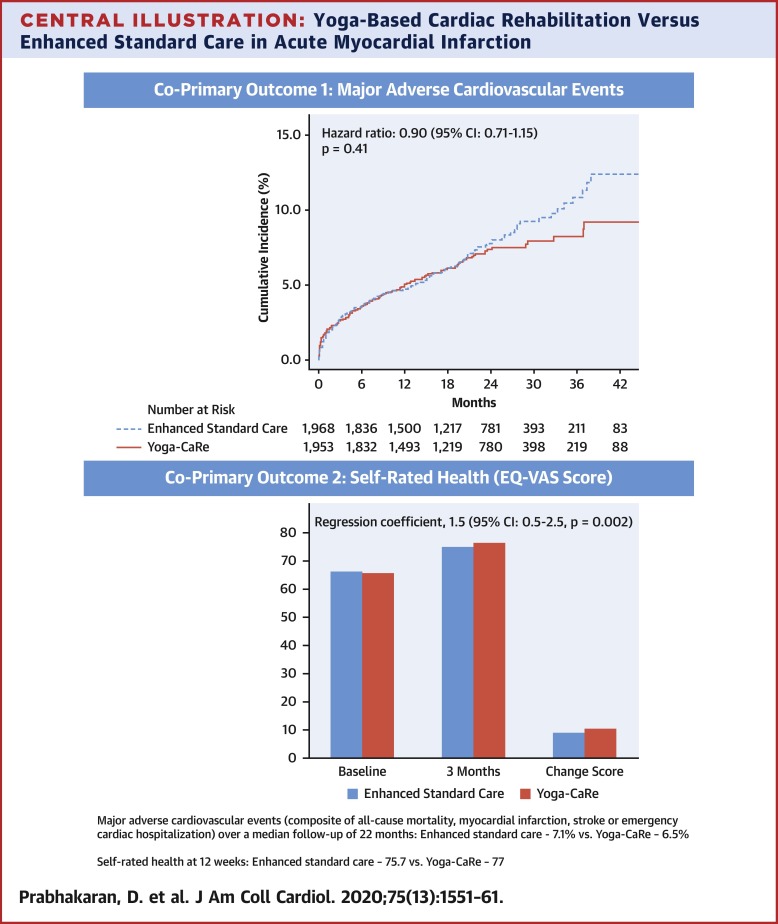当前位置:
X-MOL 学术
›
J. Am. Coll. Cardiol.
›
论文详情
Our official English website, www.x-mol.net, welcomes your feedback! (Note: you will need to create a separate account there.)
Yoga-Based Cardiac Rehabilitation After Acute Myocardial Infarction
Journal of the American College of Cardiology ( IF 24.0 ) Pub Date : 2020-04-01 , DOI: 10.1016/j.jacc.2020.01.050 Dorairaj Prabhakaran 1 , Ambalam M Chandrasekaran 2 , Kalpana Singh 2 , Bishav Mohan 3 , Kaushik Chattopadhyay 4 , Davinder S Chadha 5 , Prakash C Negi 6 , Prabhavathi Bhat 7 , Kanchanahalli S Sadananda 8 , Vamadevan S Ajay 9 , Kavita Singh 2 , Pradeep A Praveen 10 , Raji Devarajan 2 , Dimple Kondal 2 , Divya Soni 2 , Poppy Mallinson 11 , Subhash C Manchanda 12 , Kushal Madan 12 , Alun D Hughes 13 , Nishi Chathurvedi 13 , Ian Roberts 11 , Shah Ebrahim 11 , Kolli S Reddy 14 , Nikhil Tandon 15 , Stuart Pocock 11 , Ambuj Roy 15 , Sanjay Kinra 11 ,
Journal of the American College of Cardiology ( IF 24.0 ) Pub Date : 2020-04-01 , DOI: 10.1016/j.jacc.2020.01.050 Dorairaj Prabhakaran 1 , Ambalam M Chandrasekaran 2 , Kalpana Singh 2 , Bishav Mohan 3 , Kaushik Chattopadhyay 4 , Davinder S Chadha 5 , Prakash C Negi 6 , Prabhavathi Bhat 7 , Kanchanahalli S Sadananda 8 , Vamadevan S Ajay 9 , Kavita Singh 2 , Pradeep A Praveen 10 , Raji Devarajan 2 , Dimple Kondal 2 , Divya Soni 2 , Poppy Mallinson 11 , Subhash C Manchanda 12 , Kushal Madan 12 , Alun D Hughes 13 , Nishi Chathurvedi 13 , Ian Roberts 11 , Shah Ebrahim 11 , Kolli S Reddy 14 , Nikhil Tandon 15 , Stuart Pocock 11 , Ambuj Roy 15 , Sanjay Kinra 11 ,
Affiliation

|
Background Given the shortage of cardiac rehabilitation (CR) programs in India and poor uptake worldwide, there is an urgent need to find alternative models of CR that are inexpensive and may offer choice to subgroups with poor uptake (e.g., women and elderly). Objectives This study sought to evaluate the effects of yoga-based CR (Yoga-CaRe) on major cardiovascular events and self-rated health in a multicenter randomized controlled trial. Methods The trial was conducted in 24 medical centers across India. This study recruited 3,959 patients with acute myocardial infarction with a median and minimum follow-up of 22 and 6 months. Patients were individually randomized to receive either a Yoga-CaRe program (n = 1,970) or enhanced standard care involving educational advice (n = 1,989). The co-primary outcomes were: 1) first occurrence of major adverse cardiovascular events (MACE) (composite of all-cause mortality, myocardial infarction, stroke, or emergency cardiovascular hospitalization); and 2) self-rated health on the European Quality of Life–5 Dimensions–5 Level visual analogue scale at 12 weeks. Results MACE occurred in 131 (6.7%) patients in the Yoga-CaRe group and 146 (7.4%) patients in the enhanced standard care group (hazard ratio with Yoga-CaRe: 0.90; 95% confidence interval [CI]: 0.71 to 1.15; p = 0.41). Self-rated health was 77 in Yoga-CaRe and 75.7 in the enhanced standard care group (baseline-adjusted mean difference in favor of Yoga-CaRe: 1.5; 95% CI: 0.5 to 2.5; p = 0.002). The Yoga-CaRe group had greater return to pre-infarct activities, but there was no difference in tobacco cessation or medication adherence between the treatment groups (secondary outcomes). Conclusions Yoga-CaRe improved self-rated health and return to pre-infarct activities after acute myocardial infarction, but the trial lacked statistical power to show a difference in MACE. Yoga-CaRe may be an option when conventional CR is unavailable or unacceptable to individuals. (A study on effectiveness of YOGA based cardiac rehabilitation programme in India and United Kingdom; CTRI/2012/02/002408).
中文翻译:

急性心肌梗死后以瑜伽为基础的心脏康复
背景 鉴于印度心脏康复 (CR) 计划的短缺和世界范围内的心脏康复 (CR) 计划的缺乏,迫切需要找到廉价的替代 CR 模型,并且可以为吸收率低的亚组(例如,妇女和老年人)提供选择。目的 本研究旨在在一项多中心随机对照试验中评估基于瑜伽的 CR (Yoga-CaRe) 对主要心血管事件和自评健康的影响。方法 该试验在印度的 24 个医疗中心进行。该研究招募了 3,959 名急性心肌梗死患者,中位和最短随访时间分别为 22 个月和 6 个月。患者被随机分配接受 Yoga-CaRe 计划(n = 1,970)或包含教育建议的增强标准护理(n = 1,989)。共同主要结果是:1) 首次发生主要心血管不良事件 (MACE)(包括全因死亡率、心肌梗死、中风或心血管急诊住院);2) 12 周时在欧洲生活质量 – 5 维度 – 5 级视觉模拟量表上的自我评估健康。结果 Yoga-CaRe 组 131 名 (6.7%) 患者和增强标准护理组 146 名 (7.4%) 患者发生 MACE(Yoga-CaRe 的风险比:0.90;95% 置信区间 [CI]:0.71 至 1.15) ; p = 0.41)。Yoga-CaRe 的自评健康指数为 77,增强标准护理组为 75.7(支持 Yoga-CaRe 的基线调整平均差异:1.5;95% CI:0.5 至 2.5;p = 0.002)。Yoga-CaRe 组有更多的梗塞前活动回归,但治疗组之间的戒烟或药物依从性没有差异(次要结果)。结论 Yoga-CaRe 改善了自评健康状况并在急性心肌梗死后恢复了梗死前活动,但该试验缺乏统计功效来显示 MACE 的差异。当传统 CR 不可用或个人无法接受时,Yoga-CaRe 可能是一种选择。(印度和英国基于瑜伽的心脏康复计划的有效性研究;CTRI/2012/02/002408)。
更新日期:2020-04-01
中文翻译:

急性心肌梗死后以瑜伽为基础的心脏康复
背景 鉴于印度心脏康复 (CR) 计划的短缺和世界范围内的心脏康复 (CR) 计划的缺乏,迫切需要找到廉价的替代 CR 模型,并且可以为吸收率低的亚组(例如,妇女和老年人)提供选择。目的 本研究旨在在一项多中心随机对照试验中评估基于瑜伽的 CR (Yoga-CaRe) 对主要心血管事件和自评健康的影响。方法 该试验在印度的 24 个医疗中心进行。该研究招募了 3,959 名急性心肌梗死患者,中位和最短随访时间分别为 22 个月和 6 个月。患者被随机分配接受 Yoga-CaRe 计划(n = 1,970)或包含教育建议的增强标准护理(n = 1,989)。共同主要结果是:1) 首次发生主要心血管不良事件 (MACE)(包括全因死亡率、心肌梗死、中风或心血管急诊住院);2) 12 周时在欧洲生活质量 – 5 维度 – 5 级视觉模拟量表上的自我评估健康。结果 Yoga-CaRe 组 131 名 (6.7%) 患者和增强标准护理组 146 名 (7.4%) 患者发生 MACE(Yoga-CaRe 的风险比:0.90;95% 置信区间 [CI]:0.71 至 1.15) ; p = 0.41)。Yoga-CaRe 的自评健康指数为 77,增强标准护理组为 75.7(支持 Yoga-CaRe 的基线调整平均差异:1.5;95% CI:0.5 至 2.5;p = 0.002)。Yoga-CaRe 组有更多的梗塞前活动回归,但治疗组之间的戒烟或药物依从性没有差异(次要结果)。结论 Yoga-CaRe 改善了自评健康状况并在急性心肌梗死后恢复了梗死前活动,但该试验缺乏统计功效来显示 MACE 的差异。当传统 CR 不可用或个人无法接受时,Yoga-CaRe 可能是一种选择。(印度和英国基于瑜伽的心脏康复计划的有效性研究;CTRI/2012/02/002408)。


























 京公网安备 11010802027423号
京公网安备 11010802027423号